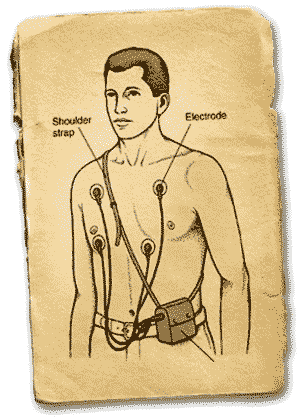| 
The following describes six different methods of managing
the patient. Which would you pursue? Click
on each link to determine the results of your evaluation.
- Send home, stop Timolol and arrange
for Holter monitor or Loop Recorder
- Since the patient was not advised of the danger of driving related
to syncope, she did not stop driving once she was sent home. As
a result the patient was involved in a motor vehicle accident;
investigation revealed that she had “blacked out at the
wheel”.
- Click here to learn more about the Holter Monitor.
- Click here to learn more about the
Loop Recorder.
- Electrophysiology Study
- Tilt Table Test
- Echocardiogram
- Admit and monitor
- Electroencephalograph
|

Holter Monitor: two surface EKG leads are recorded for a period
of 24 to 48 h.
Evaluation with a Holter Monitor is indicated:
-
if the initial EKG is normal, but the patient’s
history implies a cardiac rhythm disorder may be present.
-
to
record transient brady- or tachy-arrythmias.
One may consider using a loop recorder rather
than a Holter Monitor when:
-
a patient’s multiple near-syncope episodes
may be spaced in such a way that these episodes are liable to
be missed over the time period observed by a Holter Monitor.
-
Studies have shown that Holter monitoring records
the cardiac rhythm in only 4-10% of patients experiencing spontaneous
syncope. Loop recorders can continuously record a single EKG
lead over a time period of weeks to months.
|